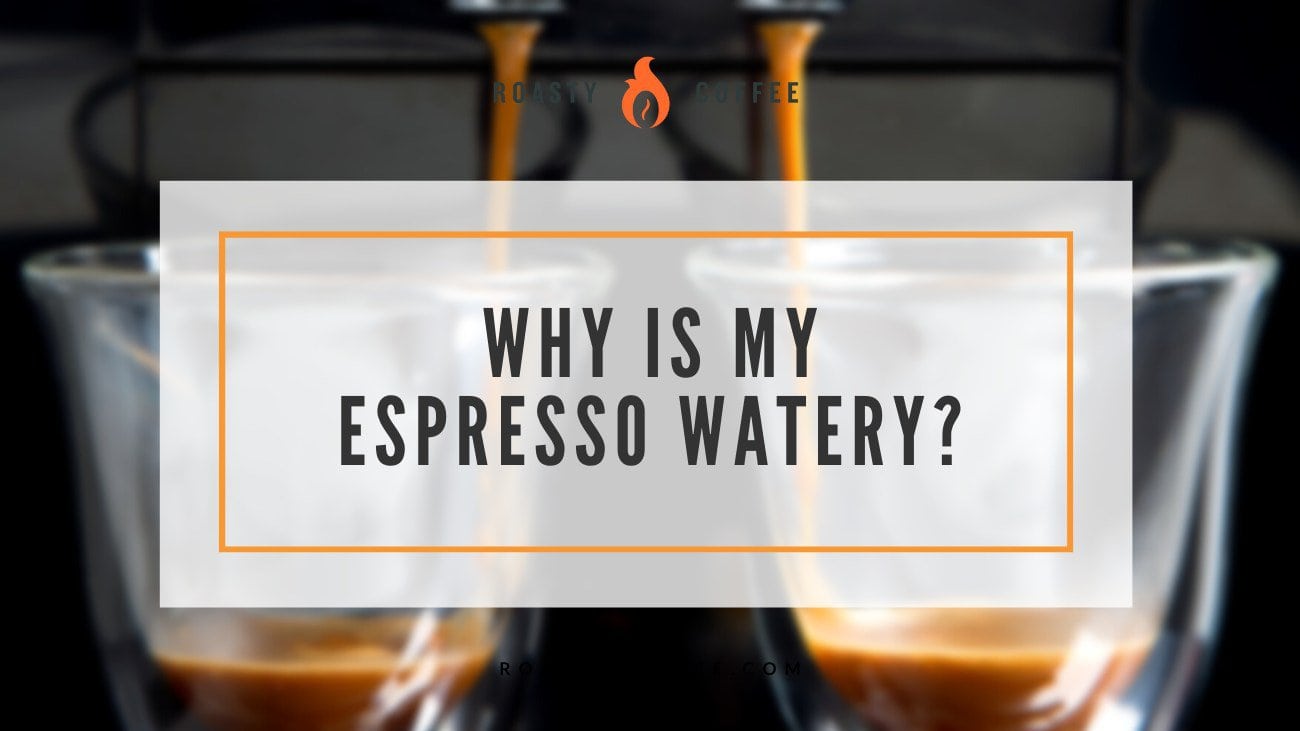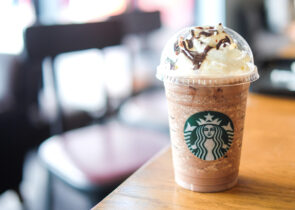Watery, thin-tasting espresso is a sign that something isn’t right in your brewing process, but we have good news! There are steps you can take to transform that watery, sad brew into the full-bodied espresso of your dreams.
Stick with us, and we’ll help you identify why you’re pulling a weak shot and troubleshoot ways to help!

What Is Watery Espresso?
Let’s start by tackling just what we mean by “watery” espresso.
Made properly, your espresso should be rich with an intense flavor and a sweet finish. This is achieved when the water extracts just the right amount of flavor-rich compounds from the ground beans.
It shouldn’t be bitter (that’s a sign of over-extraction) and it shouldn’t be sour (that’s a sign of under-extraction).
Weak, watery-tasting espresso lacks the intense flavor we expect from a perfect shot, and it’s typically a sign that the coffee is under-extracted. That means that the water that flowed through the grounds during the brewing process didn’t pull out as many flavors as it should have.
Why Is My Espresso Watery?
Don’t let weak, watery espresso get you down.
The most common reason for a watery taste is a too-fast brewing time, which can be caused by the wrong grind settings or insufficient tamping pressure.
However, proper dosage, proper water temperature, and the freshness and quality of your coffee beans also play a role in producing the perfect shot of espresso.
That said, let’s take a look at some of the most common reasons for a weak shot:
Your Coffee Beans Are Poor Quality or Stale
If you’re pulling a watery shot, consider getting fresher coffee beans.
Coffee gets its delicious flavor from volatile compounds that are produced when the beans are roasted. However, these compounds start to dissipate right after roasting.
If your beans are more than two weeks old (and most beans you’ll find on store shelves are), they won’t be able to produce a rich, flavorful shot of espresso.
Try scoring your beans from a local roaster or ordering from a roaster or subscription service that prioritizes getting beans to the consumer as quickly as possible.
Once you’ve opened your bag of coffee, keep it stored in a cool, dry, airtight place to keep it fresh for as long as possible.
You should also make sure that you’re grinding your beans right before you use them. Once the beans are ground, those tasty compounds are on the fast track out of your coffee. Pre-ground coffee is a no-no for a perfect espresso shot.
Fresh beans that are freshly ground are your ticket to excellent flavor!
Your Grind Is Off
Ah, the grind. Coffee connoisseurs of all stripes know that the perfect grind size is key to the brewing process.
Espresso should be made with finely ground coffee. A good rule of thumb is that your shot should take anywhere from 25-28 seconds to pull.
If the grind is too coarse, the water will pour through too quickly, resulting in a shot that is under-extracted and tastes weak.
If your espresso shot is pulling too quickly, try a finer grind size. It’s worth investing in a really high-quality coffee grinder for this job. Being a coffee fanatic can come with a lot of gear, but we promise it’s worth it!
You’re Not Tamping Hard Enough
When it comes to tamping your shot, there’s a sweet spot. If you tamp too hard, the water will struggle to make its way through the grounds and the shot will pull too slowly. On the flip side, if you don’t tamp hard enough, the water will flow through too quickly.
If your espresso tastes weak, the second scenario is the likely culprit, so try increasing your tamping pressure. The gold standard is 30 pounds of pressure, but when you’re tamping by hand, it will take experimentation to figure out what that feels like.
You’re Not Using Enough Coffee
The explanation for your weak espresso may be as simple as not having enough coffee grounds.
The “right” amount of grounds for a standard double shot is anywhere from 13-21 grams, depending on who you ask. Especially if you’re on the lower end of that number, you can try slowly increasing the coffee dosage you’re using, adding 0.5 g or so each time until you get the flavor you’re looking for.
Even if you’ve found your perfect dosage before, you may find that you need to tweak it when you start a new bag of coffee. Consider it part of the fun!
If you’re already toward the top end of a standard double shot dosage, explore some of our other tips instead.
It’s Not Hot, Hot, Hot Enough
To get the best flavor extraction from your espresso beans, aim for a brewing temperature of 195 to 205 degrees Fahrenheit. Hot water allows for better extraction, so if your espresso tastes weak, too-cool brewing temps could be the culprit.
If your espresso machine allows it, try increasing the brewing temperature. Just be sure not to go too high- water that is too hot will result in a burnt and bitter shot.
Your Coffee Is Channeling
Channeling who, you ask? Don’t call the priest just yet- we’re not drawing any spirits here!
‘Channeling’ is when the hot water for brewing finds a “path of least resistance” through your puck and flows quickly through, causing uneven brewing and weak, under-extracted flavor.
Proper distribution and tamping can help prevent channeling. You can purchase distribution tools that will help, and you can also consider investing in a better tamper (a self-leveling tamper is often helpful).
Just like every aspect of pulling a great espresso shot, tamping your dose is an art, so just keep practicing and perfecting your technique!
It’s Not You, It’s the Machine
Espresso machines are appliances like any other, so if you’ve tried these tips and nothing seems to work, consider that your machine might be due for some maintenance.
Don’t forget to clean and dry your portafilters thoroughly, too! Any obstructions that interfere with water pressure can cause your espresso to taste weak.
Frequently Asked Questions
What Does Soupy Espresso Puck Mean?
If your espresso puck is soupy (wet and doesn’t hold together), it’s possible your grind is too fine.
A fine grind is good, but if the grind is too fine, water won’t be able to flow through the puck properly and can remain trapped above the puck, then dropping into the dredge box with the puck and causing it to seem watery.
On the other hand, a grind that is too coarse can also be a problem. In this case, water flows too easily and quickly through the puck, making it more watery.
If you’re still struggling with this problem, check out our full article on the topic!
Can You Run an Espresso Shot Twice?
You won’t get a great-tasting shot by running water through the same grounds twice. If you pull a great shot, you’ve extracted most of the coffee oils and compounds that impart great flavor the first time. A second pull will likely taste bitter.
Can I Add More Coffee Grounds to My Espresso?
It’s certainly possible to tweak the coffee dosage you use to brew your espresso shot. The standard double shot uses about 13-18 grams of coffee.
Feel free to try adjusting the number of grounds you use for your shot, making small adjustments until you get it to where you want.
What Kind Of Coffee Beans Should Be Used For Espresso?
You can use any kind of coffee beans you want for espresso, as long as you grind them finely.
However, most people prefer dark roast beans for espresso. Darker roast coffee tends to have a more intense flavor, and “espresso roast” typically refers to a very dark roast.
How Do I Make My Espresso Thicker?
Any of our tips for preventing watery espresso will help to produce a thicker espresso with the smooth, creamy mouthfeel you’re looking for.
Try increasing your coffee dosage, tamping harder, using a finer grind, or increasing your brew temperature (of course, only change one variable at a time- coffee is a science and an art!).
Why Does Keurig Coffee Taste Watered Down?
We don’t keep it a secret that we’re not huge Keurig fans here, but we do recognize that they have their time and place for busy coffee lovers!
If you think your Keurig coffee tastes weak, it’s probably because it is! Most K-Cups just don’t contain a very large dose of coffee. For a stronger flavor, stick to brewing smaller cups of coffee with your Keurig (after all, the amount of coffee in the pod is the same no matter how large the cup you brew is) and consider the quality of your K-Cups.
You may also want to use a reusable pod, which you can fill with freshly ground beans and more grounds if you wish.
Happy Caffeinating!







